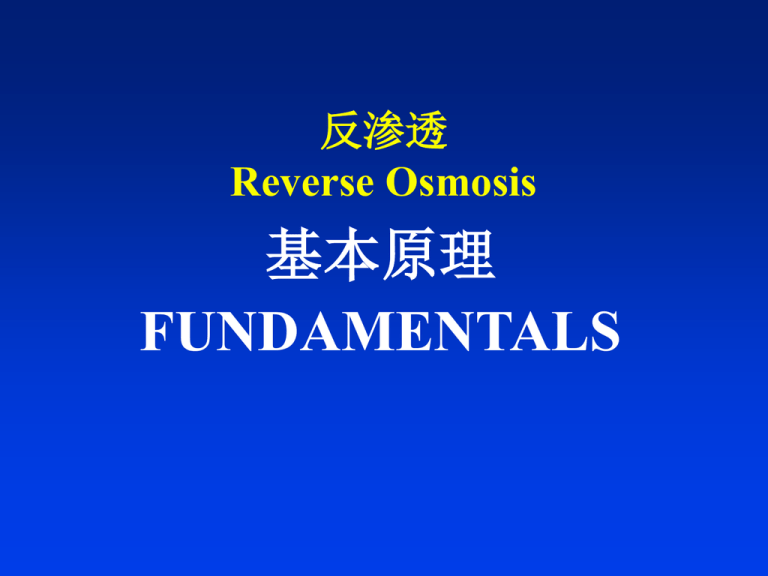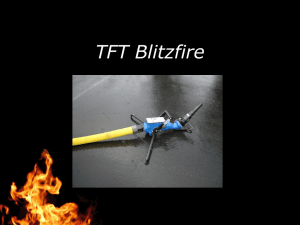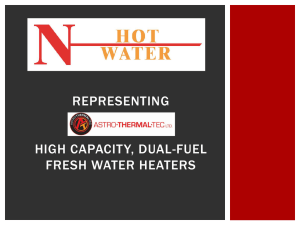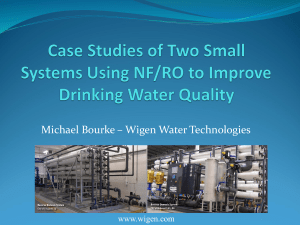反渗透基本原理
advertisement

反渗透 Reverse Osmosis 基本原理 FUNDAMENTALS 过滤类型 Types of Filtration • 死端过滤 Direct Filtration • 沙或多介质 Sand or Multi Media • 滤筒 Cartridge • 横流过滤 Cross Flow Filtration • • • • 反渗透 Reverse Osmosis 纳滤 Nanofiltroation 超滤 Ultra Filtration 微滤 Micro Filtration 进水 Feed Water 垂直过滤 Direct Filtration 产品水 Product Water 垂直过滤 Direct Filtration Product 固体表面迅速形成过滤薄膜 Solids on surface quickly foul the membrane 反洗水排放 Back Wash to Sewer 垂直过滤 反洗 Back Wash 横流过滤 Cross Flow Filtration 渗透水 Permeate 进水 Feed Water 浓水 Concentrate 横流过滤 Cross Flow Filtration 膜表面 Membrane Surface 渗透水Permeate 浓差极化 Concentration Polarization 横流过滤 Cross Flow Filtration 需求记住的事项 Things to Remember • 进水速度必须能保证固体杂质的移动 Water velocity of the feed must be sufficient to keep the solids moving. • 低流速会引起膜表面淤塞 Low water velocity will allow the membrane surface to “foul.” • 较高的水回收率(更高的水利用率)意味着较低 的水流速 Higher water recoveries (greater water utilization) means lower water velocity. 过滤型谱 The Filtration Spectrum 横流过滤 Cross Flow Filtration • 反渗透 Reverse Osmosis 溶解的固体杂质 Dissolved Solids • 纳滤 Nanofiltration 二价离子 Divalent Ions (Ca & Mg) • 超滤 Ultrafiltration 有机物和胶体 Organics & Colloids • 微滤 Microfiltration 固体悬浮物 Suspended Solids 渗透 Osmosis Osmotic Head H2O 浓溶液 Strong Solution H2O 纯水Pure Water H2O 纯水水流 Pure Water Flow 平衡 Equilibrium 应用的压力 Applied Pressure, PF 渗透压力Osmotic Pressure, PO,F H O 2 Strong Solution H2O 纯水 Pure Water H2O Osmotic Pressure, PO,P 平衡 Equilibrium 反渗透 Reverse Osmosis Applied Pressure, PF 渗透水压力 Permeate Pressure, PP Osmotic HO Pressure, PO,F 2 Strong Solution Pure Water H2O H2O Osmotic Pressure, PO,P 纯水水流 Pure Water Flow 净推动压Net Driving Pressure (NDP) 进水 Feed 渗透水 Permeate Applied Pressure, PF Permeate Pressure, PP Osmotic Pressure, PO,F Osmotic Pressure, PO,P NDP 净推动压 Net Driving Pressure • NDP = PF + PO,P - PP - PO,F • Available Pressure to “Drive” the Process • 含盐水 Brackish water PO,P = 0 各类化合物的渗透压 Osmotic Pressure of Various Compounds 渗透压 Osmotic Pressure • 100 ppm Salt 1 PSI Osmotic Pressure • 1000 ppm NaCl = 11.4 psi • 1000 ppm NaHCO3 = 12.8 psi • 1000 ppm Sucrose = 1.5 psi • 35,000 ppm Seawater = 374 psi 水中的杂质 Impurities in Water • 离子类的 Ionic 水中的杂质 Impurities in Water • 离子的 Ionic 阳离子 Ca+2 Mg+2 Na+ K+ Fe+3 Mn+2 Al3+ NH4+ 阴离子 ClNO3SO42HCO3CO32SiO2 PO43- 水中的杂质 Impurities in Water • 离子的 Ionic •非离子的 Non Ionic Impurities in Water • 有机物Organics • 离子的Ionic • 非离子的Non Ionic 酒精 Alcohols 酮 Ketones 醛 Aldehydes 苯酚 Phenols Impurities in Water • Ionic • Non Ionic • 微粒的 Particulate Impurities in Water • Ionic •固体悬浮物Suspended Solids • Non Ionic •胶质物 Colloidal Material • 微粒的 Particulate •微生物 Microbiological 细菌 Bacteria 滤过性微生物/病毒Virus 热原物质 Pyrogens 藻类 Algae 水中的杂质 Impurities in Water • Ionic • Non Ionic • Particulate • 气体类 Gases 水中的杂质 Impurities in Water • Ionic • Non Ionic • 二氧化碳Carbon Dioxide • Particulate • 氧 Oxygen • 气体类 Gases • 氯 Chlorine • 氮 Nitrogen • 硫化氢 Hydrogen Sulfide 反渗透可去除:Reverse Osmosis Removes • 离子类Ionic • 非离子类Non 不去除 Ionic • 微粒的 Particulate 气体类 Not Gases ! 溶液中的离子 Ions in Solution • 化合物在水中电离 Compounds dissolve in water to form charged ions • 阴离子 (负电 荷– 得到电子) Anions (Negative Charge - extra electrons) • 阳离子 (正电 – 丢失电子) Cations (Positive Charge - missing electrons) 离子 Ions • 丢失或得到一个电子的离子= 单价的 Ions missing or having one electron = monovalent • 丢失或得到二个电子的离子= 二价的 Ions missing or having two electrons = divalent • 丢失或得到三个电子的离子= 三价的 Ions missing or having three electrons = trivalent 离子 Ions • 单价的 Monovalent: NaCl Na+ + Cl• 二价的 Divalent : CaSO4 Ca2+ + SO42• 三价的 Trivalent : Na3PO4 3Na+ + PO43- 离子的相关渗透率 Relative Permeation Rates of Ions • 一价的 Monovalent = 1 x 10-5 cm/sec 快 • 二价的 Divalent = 1 x 10-6 cm/sec • 三价的 Trivalent = 1 x 10-7 cm/sec 慢 典型离子脱出率 Typical Passage of Ions 离子 Ion 钠 Sodium 钾 Potassium 镁 Magnesium 钙 Calcium 硅酸 Silica 氯离子 Chloride 重碳酸根 Bicarbonate 硫酸根 Sulfate TDS Mg/l 68.0 21.0 21.0 80.0 9.3 51.0 132.0 163.0 528.0 % Rejection 99.4 99.4 99.8 99.8 98.9 99.5 99.3 99.8 99.6 Determined at 200 psi, 25% recovery, pH 7.8 on de-chlorinated city feed water with TFC membrane Things to Remember 应记住的事项 Rejection Increases with Increasing 脱盐率随下列变化 • • • • Degree of dissociation电离程度 Ionic charge离子电荷 Molecular weight分子量 Degree of molecular branching分子结 构 How small is small? Inches 39.37 3.94 .39 .04 .004 .000,4 .000,04 .000,008 Meter 1 .1 .01 .001 .000,1 .000,01 .000,001 .000,000,2 5 x 10 -9 4 x 10 -10 1 Angstrom = 1 * 10 -10 m Micrometer 1,000,000 100,000 10,000 1,000 100 10 1 .1 .005 UF .000,4 RO Membrane Salt Rejection H2 O ClNa+ + Na 膜孔径 Membrane Pore Channel 反渗透 Reverse Osmosis 膜 Membranes 第一个RO膜 First RO Membrane ROGA Module #1 1964年 Semi渗透膜 Semi Permeable Membranes 制造材料 Materials of Construction • 醋酸纤维素 Cellulose Acetate • TFC膜 Thin Film Composite 聚酰胺 (Polyamide) • 聚砜 Polysulfone 不均匀/不对称膜 Asymmetric Membrane 醋酸纤维素 Cellulose Acetate 屏障层 Barrier Layer 支持 Support 分级的密度 Graded-density cellulose acetate 薄膜合成物聚酰胺膜 Thin Film Composite Polyamide Membrane 聚酰胺超薄 屏障层 Polyamide Ultra-thin Barrier Layer 0.2 micron 多微孔聚砜 40 micron Microporous Polysulfone 强化纤维 Reinforcing Fabric 120 微米 micron Compaction is not an issue Barrier Layer 聚砜 Polysulfone 支持层 Support Layer Barrier Layer Polysulfone TFC 表面 Surface 脱盐率 – 盐透过率 Salt Rejection - Salt Passage % Rejection = (TDSfeed - TDSProduct) x 100 TDSfeed % Salt Passage = TDSProduct x 100 TDSfeed 盐通量 Salt Flux Js = K2(Cm - Cp) Js = 盐通量 Salt Flux K2 = 传质系数 Mass Transfer Coefficient Cm = 膜上的浓度 Concentration at the membrane Cp = 渗透水的浓度 Concentration in the permeate 水流量 Permeate Flux Jw = K1( D P - D P) Jw = 水流量 Water Flux K1 = 系统常数/恒量System Constant P = 模跨膜压力 Transmembrane Pressure P = 渗透压 Osmotic Pressure 渗透水流量 Permeate Flux 通过一平方英尺膜面积的渗 透水流速 The rate of permeate flow through one square foot of membrane. • 10 - 25 GFD • 温度 Temperature • 压力 Pressure 膜参数对比 Membrane Comparison 特点Characteristic Opr. pH Feed Pressure Salt Rejection Water Flux Bacteria Stability Cl2 Stability Physical Stability o Max T ( F) Element Cost * System Cost * * 有关费用 Relative Cost CA 5 - 6.5 > 400 PSI OK Good Low Excellent Good 104 $1.00 $1.00 TFC 2 - 11 < 200 PSI 优 Excellent 优 Excellent 高 High 差 Poor 较好 Better 113 $1.50 $1.16 膜特点和运行条件 Membrane Characteristics and Typical Operating Conditions CA Salt Rejection 90-96% Silica Rejection 85% Nitrate Rejection 85% Cl2 Tolerance 0.2 - 1.0 SDI Max 5 Temp Range oF) 32 - 95 Op. Pressure 400 pH Range 5-6.5 Flux Rate (GPD/Ft2) 12 - 16 Bio Resistance 差 Poor 3 rd Year Compaction 20% 2X 水解 Hydrolysis TFC > 99% 98% 94% 0 3-5 32 - 113 < 200 2 - 11 15 -20 Excellent 0 None 膜生产商 Membrane Manufacturers • • • • • • • • Dow Filmtec Fluid Systems - Koch Hydranautics - Nitto Denko Osmonics - Desal Dupont - Out of membrane business Torray Toyobo Trisep 反渗透 Reverse Osmosis 膜构造 Membrane Configurations 膜构造 Membrane Configurations • • • • 卷式 (R/O > 99% USA) Spiral Wound 中空纤维 Hollow Fiber 管状 Tubular 板式 Plate and Frame 卷式膜 Spiral Wound Membranes • 醋酸纤维素 Cellulose Acetate • 薄膜合成物 Thin Film Composite 聚酰胺 (Polyamide) • 聚砜 Polysulfone 卷式膜构造 Spiral Wound Membrane Elements 卷式膜水流状态 Flow Pattern for a Spiral Wound Element 回收率 Permeate Recovery 进水 Feedwater 渗透水 Permeate 浓水 Concentrate 通过压力容器的水流 Flow Through a Pressure Vessel 盐水更加浓 Brine becomes more concentrated 产品水 Product 进水 Feed 浓水 Concentrate Minimum Element Flow 通过压力容器最后一个膜元件时流速最低 The minimum flow rate through the last element of a pressure vessel 反渗透 Reverse Osmosis 系统设计和运行 System Design & Operation RO系统变量 RO System Variables • 回收率 Permeate Recovery • 水通量Permeate Flux • 最低(通过元件的)浓水流量 Min. Element Concentrate Flow 浓缩倍数和 回收率 Concentration Factor vs. Recovery 蒸发 Evaporation 补水 Make UP Blow Down 浓缩倍数和回收率 Concentration Factor vs. Recovery Conc. Factor (x) = Flowfeed Flowbrine Conc. Factor = 1 (1 - Recovery) 回收率与浓缩倍数 Recovery vs. Concentration Factor Recovery Concentration Factor 50% 2 75% 4 80% 5 90% 10 95% 20 97.5% 40 98% 50 影响回收率的因素 Factors Influencing Recovery • 成垢离子的浓度 Concentration of scale forming salts • 渗透压力 Osmotic pressure • 产品水质量 Permeate quality 影响水通量的因素 Factors Influencing Flux • 依据给水的污垢特点 Dependent on fouling characteristics of the feed water Wastewater (SDI < 5) Surface Water (SDI <5) Well Water (SDI <3) RO Permeate 8 - 12 GFD 10 - 14 GFD 14 - 18 GFD 18 - 30 GFD RO 系统 分段 Reject Staging AKA: multi-stage多段 提高水回收 Improves water recovery Multi - Pass AKA: product staging 提高水质 Improves water quality Single-Stage RO System TRAIN #1 进水FEED 渗透水 PERMEATE 高压泵 HIGH PRESSURE PUMP TRAIN #2 容器 VESSEL 元件 ELEMENTS 盐水 BRINE Two Stage RO System 2:1 Array 渗透水 PERMEATE 50 GPM 100 PPM 进水 FEED 100 GPM 1000 PPM PERMEATE 75 GPM 130 PPM 1st STAGE CONCENTRATE 2nd STAGE FEED 50 GPM 1900PPM 回收 Recovery = 75% Salt Rejection = 87% PERMEATE 25 GPM 190 PPM CONCENTRATE 25 GPM 3920 PPM 二段RO系统的操作数据 Typical Operating Data for Two Stage RO System Item 1st Stage 2nd Stage Total System 进水流量 Feed flow 渗透水流量 Permeate flow 浓水流量 Concentrate flow 100 GPM 50 GPM 50 GPM 50 GPM 25 GPM 25 GPM 100 GPM 75 GPM 25 GPM 回收率 Recovery 50% 50% 75% Feed TDS Permeate TDS Concentrate TDS 1000 ppm 40 ppm 1960 ppm 1960 ppm 70 ppm 3850 ppm 1000 ppm 50 ppm 3850 ppm Feed Conductivity Permeate Conductivity Concentrate Conductivity 1414 mmho 60 mmho 2700 mmho 2700 mmho 104 mmho 5030 mmho 1414 mmho 75 mmho 5030 mmho Percent Salt Rejection 96% 96.4% 95% 进水压力 Feed Pressure 250 psi 渗透水压力 Permeate Pressure 10 psi 浓水压力 Concentrate Pressure230 psi 230 psi 10 psi 210 psi 250 psi 10 psi 210 psi Feed/Concentrate D P 跨膜压力TransmembraneDP 20 psid 240 psid 20 psid 220 psid 40 psid 240 psid Membrane area / vessel Flux 容器流量(avg.) 3720 ft2 19.4 gsfd 1860 ft2 19.4 gsfd 5580 ft2 19.4 gsfd Reject Staging • 提高水的利用率 Increased Utilization of Water 投资增加 Incremental Increase in Investment 最大限度提高产品水水质 Minimal Degradation in Water Quality Average Rejection 平均脱盐率 • 平均膜进水TDS Average Membrane Feed TDS = 进水Feed TDS + 浓水Concentrate TDS 2 • % Membrane Rejection = Average Feed TDS - Permeate TDS x100 Average Feed TDS 平均浓度 Average Concentration • …对数计算 Log Mean Calculation: CAVG = CF ln (CF/CC) 1 - (CF/CC) CAVG CC CF = 系统中平均浓度 Average Concentration in System = 浓水浓度 Concentration of Concentrate = 进水浓度 Concentration of Feedwater 二级RO系统 Double Pass RO System 2:1 Array PERMEATE 50 GPM 100 PPM 进水FEED 100 GPM 1000 PPM 渗透水 PERMEATE 35 GPM 2 PPM 2nd Stage Reject 15 GPM 328 PPM Reject Recycle Double Pass Product Staging • 应用 Applications: 海水 Seawater (High TDS) 超高纯度使用 Ultra-high purity applications • 级间pH值的调节 Interstage pH adjustment w/ NaOH Improved Alkalinity Rejection Improved Silica Rejection Improved TOC Rejection





